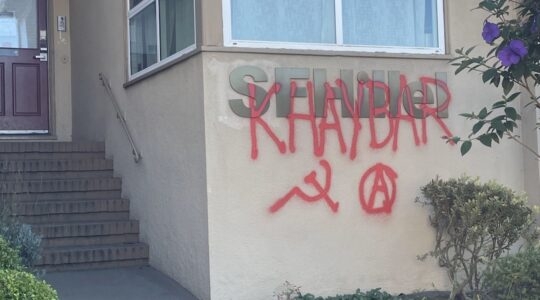SAN FRANCISCO (JTA) — When Ikar, a 3-year-old congregation in Los Angeles, wants to make an announcement to the 1,500 people on its mailing list, it doesn’t send a letter. It sends an e-mail. “We’ve never sent out a piece of hard mail,” says Joshua Avedon, who is in charge of technology for the young, unaffiliated community that describes itself as “traditional yet progressive.” That’s not all they use the Internet for. “We get people interested in Ikar who don’t live here, who follow us” via the community’s Web site and then show up if they move to Los Angeles, Avedon says. “We have donors in New York and Jerusalem who have never been here.” Keeping people virtually abreast of the group’s activities is “a way of creating a global constituency,” Avedon says. For dozens of new congregations and minyans, or prayer communities, like Ikar, the Internet is not just a faster, more convenient communication tool. It’s a central organizing mechanism and community-building tool, filling the roles performed in more traditional synagogues by administrative staff, newsletters, membership committees, religious school, even rabbis. The expected Feb. 16 launch of shulshopper.com, an interactive tool that will allow people to find and rate local synagogues, aims to take the global Jewish conversation to a new level. “The Internet is critical,” says Avedon, who also is communications director for Synagogue 3000, which works with emerging Jewish communities nationwide. Without the Internet, many of these new Jewish communities wouldn’t even exist. Kol Zimrah, an independent minyan in New York, has no building of its own but meets once a month at various locations. It sends out an e-mail to the 500 people on its list telling them when and where services will take place. “All of our communication is over the Internet,” Kol Zimrah co-founder Ben Dreyfus says. “We don’t have a phone list or snail mail.” In fact, he continues, the minyan was started five years ago by people “sending an e-mail around.” Kol Zimrah posts the music it uses for people to download, learn and use at their own services. “It’s a way of teaching people,” Dreyfus says. The Internet also enables interaction with a congregation. Elie Kaunfer, a founder of Kehilat Hadar in New York, says members and other participants “sign up for programs, offer feedback and pay for events online.” Not only is the Web convenient, it enables young, fiscally challenged Jewish communities to cast a wider net and “advertise” their activities for free. Hadar doesn’t spend any money on marketing, Kaunfer says. That’s crucial for the many communities that do not charge fixed dues. Kavana, an independent Jewish community in Seattle, draws its members — or partners, as the community calls them — largely from young Jews who moved to the city to work in the high-tech industry. The Internet “helps us assess how we are delivering our services, how we get retention of people,” notes Suzi LeVine, who used to work at Microsoft and Expedia. Kavana maintains online charts to track how people move from attending one event to attending three, to finally joining the community. All this puts pressure on the communities to keep their sites looking spiffy. Shira Cohen, communications director for Minyan Tehillah in Cambridge, Mass., notes that the group’s Web site has not been updated since it was created nearly four years ago — and the young people drawn to these groups have high Web standards. “We realize that when people visit the area and are looking for minyanim of this type, they’ll Google us, and if our site looks bad, they probably won’t come,” she says. A new tool was to be added when Daniel Sieradski, founder of the jewschool blog, was expected to launch ShulShopper. Sieradski pledges it will “provide the greater Jewish community with entirely free tools and resources conducive to independent Jewish learning and community organizing.” The site will post descriptions of congregations written by its members, and users can log on to look for the congregations that best fit their needs. They can search by various factors, including level of observance, denominational affiliation, size and interfaith friendliness. ShulShopper will function like a wiki, allowing users to contribute to congregational profiles and “review” their worship experiences — something that makes several people who wrote to Sieradski’s blog nervous. Sieradski says ShulShopper is “an experiment,” the hoped-for first step in a more extensive site called Jew It Yourself. That larger venture, he says, will host congregations’ social networks and provide tools for independent Jewish study. One idea Sieradski has is an online beit midrash, or study hall, where “people in Jerusalem and Houston can turn the same page” of text on-screen. Certainly there is a generational shift behind this reliance on the Web. The new congregations, minyans or communities — whatever they choose to call themselves — are organized by or include Jews in their 20s and 30s who grew up with the Internet and are accustomed to interacting with others via computer screen. While their parents might find this technology impersonal, they don’t. “The Internet fosters a degree of intimacy you rarely get elsewhere,” says Avedon, who notes that Internet use “is slowly infiltrating” older, established congregations. Rabbis of these new communities share their deepest thoughts on blogs. Other blogs, like jewschool, “allow you to see the inside of the counter-cultural Jewish world,” something that in the pre-Web world “you’d need to sit in a smoke-filled cafe” to see, he says. The Web fosters social networking. Many independent minyans and their members post their profiles on MySpace or Facebook, popular online communities. That helps sustain relationships among members of a congregation between the times they actually see each other. Kol Zimrah just started a Facebook group, says member Elizabeth Richman, a rabbinical student at the Jewish Theological Seminary. One woman used it to compliment the curry served at a recent Shabbat meal. The next week, Kol Zimrah member Dreyfus ran into the woman at Hadar, recognized her from Facebook and told her where to find the curry recipe. “That’s a phenomenal cycle of technology allowing interaction between human beings,” Richman says, “and Ben got to meet someone he didn’t know.”
JTA has documented Jewish history in real-time for over a century. Keep our journalism strong by joining us in supporting independent, award-winning reporting.





